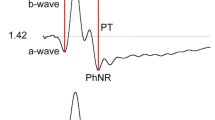Abstract
The achievement of a sharp retinal signal depends on many factors, particularly the stability of the electrodes on the corneal surface, the maximal reduction of electrical and electromagnetic disturbances and the avoidance of the noise caused by events that are synchronous with the stimulation. The availability of a low-noise recording system becomes critical in the detection of the electroretinogram in patients with retinitis pigmentosa. We studied an electroretinographic recording technique specifically designed to enhance the signal-to-noise ratio in patients with retinitis pigmentosa. The main features of the method are a membrane suction pump connected to the corneal electrodes to improve contact lens stability on the corneal surface, and a differential derivation system to record the signal. One corneal electrode is used as the recording electrode, while the other, acting as the reference electrode, is covered during full-field ganzfeld stimulation. In addition, computerized averaging and signal postrecording analyses were performed on 100 iterations. The methods described here resulted in a sharp reduction in the number of undetectable electroretinograms in our case material (28.8%). This investigation demonstrates that some of the undetectable signals reported in the literature may be due to noisy recording methods rather than to actually extinguished retinal responses.
Similar content being viewed by others
Abbreviations
- RP:
-
retinitis pigmentosa
- S/N:
-
signal-to-noise
References
Heckenlively JR. Retinitis pigmentosa. Philadelphia: JB Lippincott Co, 1988: 6–11.
Wu LZ, Massof RW, Starr SJ. Electroretinographic intensity-response function in retinal disease. Chin Med J 1985; 98: 250–6.
Lyness AL, Ernst WJK, Quinlan MP, Cloer GM, Arden GB, Carter RM, Bird AC, Parker JA. A clinical, psychophysical, and electroretinographic survey of patients with autosomal dominant retinitis pigmentosa. Br J Ophthalmol 1985; 69: 326–9.
Fishman GA, Alexander KR, Anderson RJ. Autosomal dominant retinitis pigmentosa. A method of classification. Arch Ophthalmol 1985; 103: 366–74.
De Rouck A, De Bie S, Kayembe D. Statistical evaluation of visual functions in dominant and recessive autosomal pigmentary retinopathy. Doc Ophthalmol 1986; 62: 265–80.
Fishman GA, Farber MD, Derlacki DJ. X-linked retinitis pigmentosa. Profile of clinical findings. Arch Ophthalmol 1988; 106: 369–75.
Iijima H, Martin DA, Heckenlively JR. Autosomal dominant retinitis pigmentosa. A log quotient analysis of the photopic and scotopic b-wave amplitude. Br J Ophthalmol 1989; 73: 337–41.
Armington JC, Gouras P, Tepas DI, Gunkel R. Detection of the electroretinogram in retinitis pigmentosa. Exp Eye Res 1961; 1: 74–80.
Marmor MF, Arden GB, Nilsson SE, Zrenner E. Standard for clinical electroretinography. Arch Ophthalmol 1989; 107: 816–9.
Berson EL, Simonoff EA. Dominant retinitis pigmentosa with reduced penetrance. Further studies of the electroretinogram. Arch Ophthalmol 1979; 97: 1286–91.
Berson EL, Sandberg MA, Rosner B, Birch DG, Hanson AH. Natural course of retinitis pigmentosa over a three-year interval. Am J Ophthalmol 1985; 99: 240–51.
Andréasson SOL, Sandberg MA, Berson EL. Narrow-band filtering for monitoring low-amplitude cone electroretinograms in retinitis pigmentosa. Am J Ophthalmol 1988; 105: 500–3.
Andréasson SOL. Electroretinographic studies of families with dominant retinitis pigmentosa. Acta Ophthalmol 1991; 69: 162–8.
Rispoli E, Vingolo EM, Rispoli D, Iannaccone A. Sodium hyaluronate (Hyalistil) in performing ERG. Boll Ocul 1991; 3: 625–30.
Marmor MF, Aguirre G, Arden G, Berson EL, Birch DG, Boughman JA, Carr R, Chatrian GE, Del Monte M, Dowling J, Enoch J, Fishman GA, Fulton AB, Garcia CA, Gouras P, Heckenlively JR, Hu DN, Lewis RA, Niemeyer G, Parker JA, Perlman I, Ripps H, Sandberg MA, Siegel I, Weleber RG, Wolf ML, Wu LZ, Young RSL. Retinitis pigmentosa. Symposium on terminology and methods of examination. Ophthalmology 1983; 90: 126–31.
Karpe G. The basis of clinical electroretinography. Acta Ophthalmol Kbh 1945; 23 (suppl.): 1–114.
Björk A, Karpe G. The clinical electroretinogram. V. The electroretinogram in retinitis pigmentosa. Acta Ophthalmol Kbh 1951; 29: 361–71.
Carr RE, Siegel IM. Electrodiagnostic testing of the visual system. A clinical guide. Chap 4. Philadelphia: FA Davis Co, 1990: 20.
Cobb WE, Dawson GD. The latency and the form in man of the occipital potentials evoked by bright flashes. J Physiol Lond 1960; 152: 108–21.
Newsome DA, Dorsey FC, May JG, Bergsma DR, Bazan NG. Ganglioside administration in retinitis pigmentosa. J Ocul Pharmacol 1987; 3: 323–32.
Finkelstein D, Massof RW, Palmer RW. Retinitis pigmentosa. Design of a pilot laser clinical trial in progress. Invest Ophthalmol Vis Sci 1988; 29 (suppl.): 142.
Vingolo EM, Rispoli E, Forte R. La retinite pigmentosa in età infantile, problematiche attuali. Proceedings of the 6th Congress of the Italian Society of Pediatric Ophthalmology, June 22–24, 1989, Sorrento, Italy. Boll Ocul 1990; 69 (suppl. 4): 89–95.
Rispoli E, Vingolo EM, Iannaccone A. Thymopentin in retinitis pigmentosa. Evaluation of its possible therapeutical effects after 18 months of treatment, preliminary results. New Trends Ophthalmol 1991; 6: 235–41.
Vingolo EM, Iannaccone A, Forte R, Pannarale L. Thymopentin. A new therapeutic approach to retinitis pigmentosa. Proceedings of the Workshop on Retinitis Pigmentosa, Rome, Institute of Ophthalmology, March 2nd, 1991. Boll Ocul 1993; 72 (suppl.1): 141–55.
Vingolo EM, Iannaccone A, Forte R, Tanzilli P, Sciò F. Thymopentin in the treatment of retinitis pigmentosa. Results after a three-year follow-up.In: Rinaldi E, ed. Retinitis pigmentosa. Present knowledge and outlook. Proceedings of the International Symposium on Retinitis Pigmentosa, April 13–15, 1992, Napoli, Italy. Napoli: Edizioni Liviana Medicina, 1993: 437–45.
Berson EL, Rosner B, Sandberg MA, Hayes KC, Nicholson BW, Weigel-Di Franco C, Willett W. A randomized trial of vitamin A and vitamin E supplementation for retinitis pigmentosa. Arch Ophthalmol 1993; 111: 761–72.
Author information
Authors and Affiliations
Rights and permissions
About this article
Cite this article
Rispoli, E., Iannaccone, A. & Vingolo, E.M. Low-noise electroretinogram recording techniques in retinitis pigmentosa. Doc Ophthalmol 88, 27–37 (1994). https://doi.org/10.1007/BF01203699
Accepted:
Issue Date:
DOI: https://doi.org/10.1007/BF01203699




